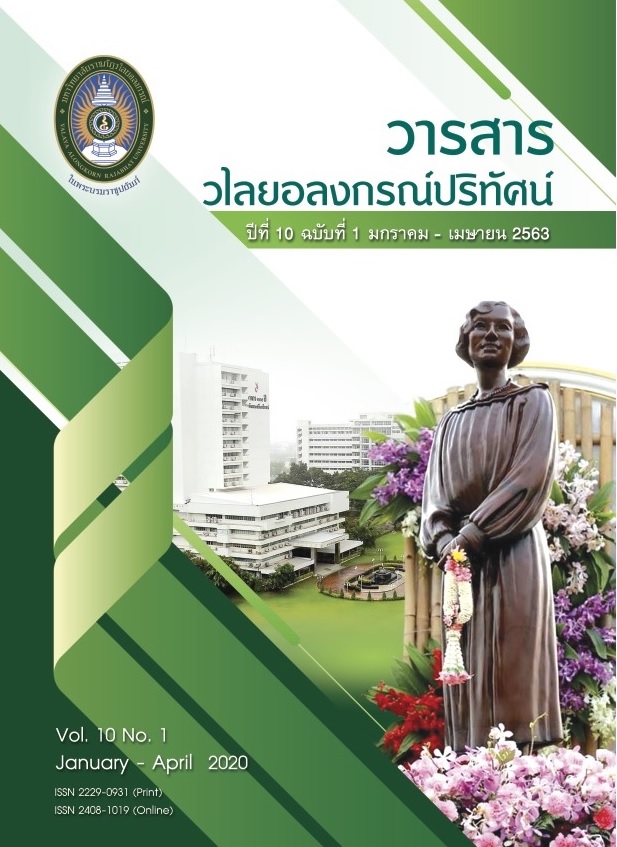การพัฒนาตัวบ่งชี้การทำงานเป็นทีมที่มีสมรรถนะสูงของโรงเรียนสังกัดเทศบาล
คำสำคัญ:
ตัวบ่งชี้, การทำงานเป็นทีมที่มีสมรรถนะสูงบทคัดย่อ
การวิจัยครั้งนี้มีวัตถุประสงค์เพื่อ 1) ศึกษาองค์ประกอบการทำงานเป็นทีมที่มีสมรรถนะสูงของโรงเรียนสังกัดเทศบาล 2) พัฒนาตัวบ่งชี้การทำงานเป็นทีมที่มีสมรรถนะสูงของโรงเรียนสังกัดเทศบาล และ 3) ตรวจสอบความตรงเชิงโครงสร้างของตัวบ่งชี้การทำงานเป็นทีมที่มีสมรรถนะสูงของโรงเรียนสังกัดเทศบาล การวิจัยนี้เป็นแบบผสานวิธี ซึ่งใช้การศึกษาเชิงคุณภาพร่วมกับเชิงปริมาณ การวิจัยเชิงคุณภาพใช้การสนทนากลุ่ม ผู้ให้ข้อมูลคือผู้ทรงคุณวุฒิ จำนวน 9 คน เลือกแบบเจาะจง เครื่องมือ ได้แก่ แบบสอบถามความคิดเห็น วิเคราะห์ข้อมูลโดยการวิเคราะห์เชิงเนื้อหา การวิจัยเชิงปริมาณกลุ่มตัวอย่างที่ใช้ในการวิจัย ได้แก่ ผู้บริหารโรงเรียนสังกัดเทศบาล โรงเรียนละ 1 คน จำนวน 540 คน โดยการกำหนดขนาดกลุ่มตัวอย่าง 20 ต่อ 1 ตัวแปร โดยการสุ่มแบบหลายขั้นตอน เครื่องมือ ได้แก่ แบบสอบถามชนิดมาตราส่วนประมาณค่า 5 ระดับ วิเคราะห์ข้อมูลโดยหาค่าไค-สแควร์ ค่าชั้นแห่งความเป็นอิสระ ค่าระดับนัยสำคัญทางสถิติ ค่าดัชนีวัดระดับความกลมกลืน
ค่าดัชนีวัดระดับความกลมกลืนที่ปรับแก้แล้ว และค่าดัชนีรากที่สองเฉลี่ยของความคลาดเคลื่อนในการประมาณค่า
ผลการวิจัยพบว่า
1. องค์ประกอบการทำงานเป็นทีมที่มีสมรรถนะสูงของโรงเรียนสังกัดเทศบาล ประกอบด้วย 5 องค์ประกอบ ได้แก่ 1) การไว้วางใจ 2) การยอมรับนับถือ 3) การกำหนดเป้าหมายร่วมกัน 4) การติดต่อสื่อสาร และ 5) การสร้างความร่วมมือ
2. ตัวบ่งชี้องค์กรสมรรถนะสูงของสถานศึกษา สังกัดสำนักงานเขตพื้นที่การศึกษาประถมศึกษา ประกอบไปด้วย 22 ตัวบ่งชี้ ดังนี้ 1) การไว้วางใจ มี 4 ตัวบ่งชี้ ได้แก่ การสร้างมนุษยสัมพันธ์ ความสามารถในการทำงาน รักษาความเชื่อมั่น และการยึดหลักความซื่อสัตย์ 2) การยอมรับนับถือมี 5 ตัวบ่งชี้ ได้แก่ การวางคนเหมาะสมกับงานยอมรับกฎ กติกาของทีม ยอมรับความแตกต่าง เคารพบทบาทหน้าที่ซึ่งกันและกัน และการเปลี่ยนกันเป็นผู้นำและผู้ตาม 3) การกำหนดเป้าหมายร่วมกัน มี 4 ตัวบ่งชี้ ได้แก่ กำหนดวิสัยทัศน์ร่วมกัน รับรู้และเข้าใจเป้าหมายร่วมกัน ยึดมั่น ในเป้าหมายการทำงาน และกำหนดกรอบเวลาแต่ละเป้าหมาย 4) การติดต่อสื่อสาร มี 5 ตัวบ่งชี้ ได้แก่ มีการสื่อสารแบบเปิดเผย มีการแลกเปลี่ยนข้อมูล มีปฏิสัมพันธ์กันระหว่างสมาชิกทีม รับฟัง ความคิดเห็นด้วยความจริงใจ และการทำงานข้ามสายงาน 5) การสร้างความร่วมมือ มี 4 ตัวบ่งชี้ ได้แก่ การสร้างแรงจูงใจในการทำงาน การส่งเสริมการมีส่วนร่วม การปฏิบัติตามหน้าที่และการประเมินผลการดำเนินงาน
3. ผลการทดสอบความสอดคล้องของโมเดลความสัมพันธ์เชิงโครงสร้างการพัฒนาตัวบ่งชี้ขององค์ประกอบการทำงานเป็นทีมที่มีสมรรถนะสูงของโรงเรียนสังกัดเทศบาล การทดสอบสมมติฐานการวิจัยพบว่า โมเดลมีความสอดคล้องกับข้อมูลเชิงประจักษ์ โดยมีค่าไค-สแควร์เท่ากับ 125.19 ค่าชั้นแห่งความเป็นอิสระเท่ากับ 106 ค่าระดับนัยสำคัญทางสถิติเท่ากับ .05 ค่าดัชนีวัดระดับความกลมกลืนเท่ากับ 0.98 ค่าดัชนีวัดระดับความกลมกลืนที่ปรับแก้แล้วเท่ากับ 0.95 และค่าดัชนีรากที่สองเฉลี่ยของความคลาดเคลื่อนในการประมาณค่าเท่ากับ .01
เอกสารอ้างอิง
กมลนิตย์ วิลัยแลง. (2559). ประสิทธิภาพการทำงานเป็นทีมของข้าราชการครูโรงเรียนในสังกัดองค์การบริหารส่วนจังหวัดระยอง. วิทยานิพนธ์การศึกษามหาบัณฑิต สาขาวิชาการบริหารการศึกษา มหาวิทยาลัยบูรพา.
กัญวัญญ์ ธารีบุญ. (2557). การบริหารแบบมีส่วนร่วมที่ส่งผลต่อประสิทธิภาพการทำงานเป็นทีมของผู้บริหารสถานศึกษาเอกชนระดับปฐมวัย. วิทยานิพนธ์ศึกษาปรัชญาดุษฎีบัณฑิต สาขาวิชาการบริหารการศึกษา มหาวิทยาลัยศิลปากร.
จริยา เห็นงาม. (2559). ความพึงพอใจในการทำงานเป็นทีมของข้าราชการครูโรงเรียนมัธยมศึกษาในจังหวัดระยอง สังกัดสำนักงานเขตพื้นที่การศึกษามัธยมศึกษา เขต 18. วิทยานิพนธ์การศึกษามหาบัณฑิต สาขาวิชาการบริหารการศึกษา มหาวิทยาลัยบูรพา.
จารุวัจน์ สองเมือง. (2559). การบริหารสถานศึกษาในศตวรรษที่ 21. สืบค้นจาก https://tawasau.ftu.ac.th/jaruwut/?p=136.
ชยพล บุตรศาสตร์. (2554). การทำงานเป็นทีมของข้าราชการครูและบุคลากรทางการศึกษาในโรงเรียนระดับประถมศึกษา อำเภอโป่งน้ำร้อน สังกัดสำนักงานเขตพื้นที่การศึกษาประถมศึกษาจันทุบรี เขต 2. วิทยานิพนธ์การศึกษามหาบัณฑิต สาขาวิชาการบริหารการศึกษา มหาวิทยาลัยบูรพา.
นงลักษณ์ วิรัชชัย และคณะ. (2551). การพัฒนาตัวบ่งชี้คุณธรรมจริยธรรม: การพัฒนาและพัฒนาการ. กรุงเทพฯ: ศูนย์ส่งเสริมและพัฒนาพลังแผ่นดินเชิงคุณธรรม.
นุสินธุ์ รุ่งเดช. (2556). การพัฒนาตัวบ่งชี้การบริหารโดยใช้โรงเรียนเป็นฐานในสถานศึกษาขั้นพื้นฐาน. วิทยานิพนธ์การศึกษาดุษฎีบัณฑิต สาขาวิชาการบริหารการศึกษา มหาวิทยาลัยบูรพา.
ไพฑูรย์ สินลารัตน์. (2560). ความเป็นผู้นำทางการศึกษา. กรุงเทพฯ: วิทยาลัยครุศาสตร์ มหาวิทยาลัยธุรกิจบัณฑิตย์.
ไพวัล ไชยทองศรี. (2558). การพัฒนาตัวบ่งชี้การทำงานเป็นทีมของครูในสถานศึกษาขั้นพื้นฐาน. วิทยานิพนธ์ครุศาสตรดุษฎีบัณฑิต สาขาวิชาการบริหารการศึกษา มหาวิทยาลัยราชภัฏมหาสารคาม.
วิรัช สงวนวงศ์วาน. (2559). การจัดการและพฤติกรรมองค์การ. กรุงเทพฯ: ท้อป.
สุวรรณา พงษ์ผ่องพูล. (2558). การทำงานเป็นทีมที่ส่งผลต่อการบริหารงานวิชาการของสถานศึกษา สังกัดสำนักงานเขตพื้นที่การศึกษาประถมศึกษาปทุมธานี เขต 2. วิทยานิพนธ์ศึกษาศาสตรมหาบัณฑิต สาขาวิชาการบริหารการศึกษา มหาวิทยาลัยเทคโนโลยีราชมงคลธัญบุรี.
อำนวย มีสมทรัพย์. (2553). ความสัมพันธ์ระหว่างการทำงานเป็นทีมกับการบริหารงานวิชาการของสถานศึกษา สังกัดสำนักงานเขตพื้นที่การศึกษาพระนครศรีอยุธยา เขต 1. วิทยานิพนธ์ครุศาสตรมหาบัณฑิต สาขาวิชาการบริหารการศึกษา มหาวิทยาลัยราชภัฏพระนครศรีอยุธยา.
Cattell, R. B. (1948). Concepts and Methods in the Measurement of Group Syntality. Psychological Review. 55, 48-63.
Homans, C. G. (1961). Social Behavior: Its Elementary Forms. New York: Harcunt Brace and World Moreman.
Marshall, E. M. (2000). Building Trust at the Speed Change: The Power of the Relationship Based Corporation. New York: AMACOM.
Plymouth State University. (2003). Area of Concern/Targets for Growth Indicators. [Online] Available: https://www.plymouth.edu/educate/growth_indicators.pdf
Robbins, S. P. (2005). Essentials of Organizational Behavior. (8th ed.). New Jersey: Pearson Prentice Hall.
Stogdill, R. M. (1974). Handbook of Leadership: A survey of Theory and Research. New York: Free Press.
Swansburg, R. C. & Swansburg, R. J. (2002). Introduction Management and Leadership for Nurse Manager. (3th ed.). Boston: Jones and Bartlett publishers.
ดาวน์โหลด
เผยแพร่แล้ว
รูปแบบการอ้างอิง
ฉบับ
ประเภทบทความ
สัญญาอนุญาต
ข้อความที่ปรากฏในบทความแต่ละเรื่องในวารสารวไลยอลงกรณ์ปริทัศน์ เป็นความคิดเห็นของผู้นิพนธ์แต่ละท่าน มิใช่เป็นทัศนะและมิใช่ความรับผิดชอบของกองบรรณาธิการจัดทำวารสาร และ
มหาวิทยาลัยราชภัฏวไลยอลงกรณ์ ในพระบรมราชูปถัมภ์


